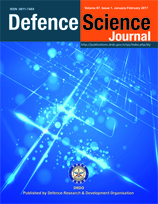Automatic Intruder Combat System: A way to Smart Border Surveillance
DOI:
https://doi.org/10.14429/dsj.67.10286Keywords:
Border Surveillance, Intruders, Human detection, Fence detection, Combat, Optical flowAbstract
Security and safeguard of international borders have always been a dominant issue for every nation. A large part of a nation’s budget is provided to its defense system. Besides wars, illegal intrusion in terms of terrorism is a critical matter that causes severe harm to nation’s property. In India’s perspective, border patrolling by Border Security Forces (BSF) has already been practiced from a long time for surveillance. The patrolling parties are equipped with high-end surveillance equipments but yet an alternative to the ply of huge manpower and that too in harsh environmental conditions hasn’t been in existence. An automatic mechanism for smart surveillance and combat is proposed in this paper as a solution to the above-discussed problems. Smart surveillance requires automatic intrusion detection in the surveillance video, which is achieved by using optical flow information as motion features for intruder/human in the scene. The use of optical flow in the proposed smart surveillance makes it robust and more accurate. Use of a simple horizontal feature for fence detection makes system simple and faster to work in real-time. System is also designed to respond against the activities of intruders, of which auto combat is one kind of response.References
Moeslund, Thomas B., Adrian Hilton, and Volker Krüger. "A survey of advances in vision-based human motion capture and analysis." Computer vision and image understanding 104.2 (2006): 90-126.
Zhang, Lijing, and Yingli Liang. "Motion human detection based on background subtraction." Education Technology and Computer Science (ETCS), 2010 Second International Workshop on. Vol. 1. IEEE, 2010.
Wu, Jianxin, et al. "C4: A Real-Time Object Detection Framework." Image Processing, IEEE Transactions on 22.10 (2013): 4096-4107.
Viola, Paul, and Michael Jones. "Robust real-time object detection."International Journal of Computer Vision 4 (2001): 51-52.
Jones, Michael J., and James M. Rehg. "Statistical color models with application to skin detection." International Journal of Computer Vision 46.1 (2002): 81-96.
Zhao, Xiaohui. "Research of self-adaptive chroma space model skin-color algorithm based on illumination and its application to erotic webpage filtering."Networking and Digital Society (ICNDS), 2010 2nd International Conference on. Vol. 2. IEEE, 2010.
"Border Patrol: Goals and Measures Not Yet in Place to Inform Border Security Status and Resource Needs," Government Accountability Office Report 113-330T, February 26, 2013.
Hayes, Ben, and Mathias Vermeulen. "Borderline: the EU’s new border surveillance initiatives." Heinrich Böll Foundation (June 2012) (2012): 74-76.
Das, Pushpita. "Issues in the Management of the India–Pakistan International Border." Strategic Analysis 38.3 (2014): 307-324.
Heikkilä, Marko, and Matti Pietikäinen. "A texture-based method for modeling the background and detecting moving objects." Pattern Analysis and Machine Intelligence, IEEE Transactions on 28.4 (2006): 657-662.
Ye, Jianhua, Tao Gao, and Jun Zhang. "Moving object detection with background subtraction and shadow removal." Fuzzy Systems and Knowledge Discovery (FSKD), 2012 9th International Conference on. IEEE, 2012.
Dalal, Navneet, and Bill Triggs. "Histograms of oriented gradients for human detection." Computer Vision and Pattern Recognition, 2005. CVPR 2005. IEEE Computer Society Conference on. Vol. 1. IEEE, 2005.
Han, Hong, and Minglei Tong. "Human detection based on optical flow and spare geometric flow." Image and Graphics (ICIG), 2013 Seventh International Conference on. IEEE, 2013.
Mahmoudi, Sidi Ahmed, et al. "Real-time motion tracking using optical flow on multiple GPUs." Bulletin of the Polish Academy of Sciences: Technical Sciences 62.1 (2014): 139-150.
Aslani, Sepehr, and Homayoun Mahdavi-Nasab. "Optical flow based moving object detection and tracking for traffic surveillance." International Journal of Electrical, Electronics, Communication, Energy Science and Engineering 7.9 (2013): 789-793.
Park, Ki-Yeong, and Sun-Young Hwang. "An improved Haar-like feature for efficient object detection." Pattern Recognition Letters 42 (2014): 148-153.
Singh, Dushyant Kumar, and Dharmender Singh Kushwaha. "Tracking Movements of Humans in a Real-Time Surveillance Scene." Proceedings of Fifth International Conference on Soft Computing for Problem Solving. Springer Singapore, 2016.
Downloads
Published
How to Cite
Issue
Section
License
 Where otherwise noted, the Articles on this site are licensed under Creative Commons License: CC Attribution-Noncommercial-No Derivative Works 2.5 India
Where otherwise noted, the Articles on this site are licensed under Creative Commons License: CC Attribution-Noncommercial-No Derivative Works 2.5 India


